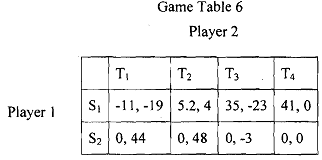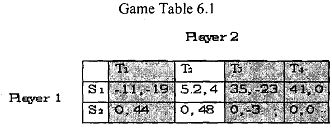Iterated elimination of strictly dominated strategies:
For obvious reasons, no rational player will play strictly dominated strategy (as dominated strategies render less payoff whatever be the opponents strategy). This idea can be used to find the solution of a game. Consider the following example:
Example:

Player 1: Neither S1 nor S2 is strictly dominant.
Player 2: T2 strictly dominant strategy (check it out yourself).
Therefore, player 2 will play T2 only, and hence the game table reduces to the unshaded region of Game Table

Now, in the reduced game table for player S1 is the strictly dominating strategy. Therefore, player1 will choose S1. So, the solution of the game is (S1, T2).
From a game table, we can reach the solution by eliminating the strictly dominated strategies. This process of obtaining solution of a game is known as called iterated elimination of strictly dominated strategies (IESDS).
Although the process is based on the appealing idea that rational players do not play strictly dominated strategies, it has two drawbacks, viz.,
i) in each step each player assumes that the other player is rational. That is, we need to assume that not only players are rational, but they also know that all players are rational and their rivals also know that she knows that she is rational, and so on ad infinitum. This chain of information is known as common knowledge. Therefore, we need to assume that players are rational and rationality is common knowledge;
ii) there could be situations in which no strategy is strictly dominated. Tn that case, we cannot apply IESDS to reach the solution.